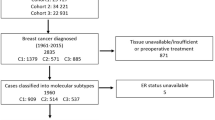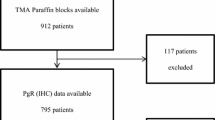Abstract
One hundred and nineteen patients with breast cancer had 2 or more lesions removed for oestrogen (REc) or progesterone receptor (RPc) assay, either synchronously (on 38 occasions) or after an interval (on 91 occasions). In all but 7 both receptors were assayed for each lesion. The assays did not agree on the presence or absence of REc alone, RPc alone or the combination of both receptors in 11, 13 and 16% respectively of the synchronous samples, compared with 23, 30 and 43% of the asynchronous samples. The differences between the synchronous and asynchronous samples were significant for the combined receptors (P = 0.007) but not for REc (P = 0.176) or RPc alone (P = 0.077). Variation between asynchronous biopsies was greater when the earlier lesion contained RPc (18/37 disagreed) than when it did not (8/50) disagreed, P = 0.0023). This was not true for oestrogen receptor. In those remaining receptor positive there was only a weak correlation between the first and second values (Spearman rank correlation coefficient, rho = 0.39 for REc, P less than 0.02, and 0.45 for RPc, 0.05 less than P less than 0.1). Receptor levels and receptor status may change with time. Biopsy is most appropriate at the time when systemic treatment is proposed.
Similar content being viewed by others
Rights and permissions
About this article
Cite this article
Harland, R., Barnes, D., Howell, A. et al. Variation of receptor status in cancer of the breast. Br J Cancer 47, 511–515 (1983). https://doi.org/10.1038/bjc.1983.81
Issue Date:
DOI: https://doi.org/10.1038/bjc.1983.81
- Springer Nature Limited
This article is cited by
-
Absence of progesterone receptor associated with secondary breast cancer in postmenopausal women
British Journal of Cancer (1999)
-
Nandrolone decanoate added to tamoxifen in the treatment of advanced breast cancer
Breast Cancer Research and Treatment (1985)
-
The relationship between estrogen receptors in primary and secondary breast carcinomas and in sequential primary breast carcinomas
Breast Cancer Research and Treatment (1985)




